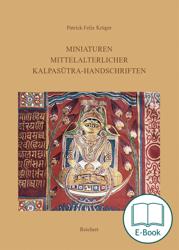The focus of this study on Indian book illumination are the miniatures of six Jain Kalpasūtra manuscripts produced in western India (Gujarat and Rajasthan) as well as in Jaunpur, the capital of a Sultanate located further to the northeast, during the 15th and 16th centuries; all manuscripts belong to the so-called 'Western Indian School'. The study starts with an art-historical examination of the individual motifs and pictorial contents. In a second step their position is defined within the framework of literary history of the texts they are associated with. Furthermore, the contents of the pictures will be located in their cultural, religious, and historical context and their symbolism will be explained
West Indian book illumination is among the rarely treated fields of South Asian art history, even though Jain manuscripts of the West Indian schools of painting include some of the oldest surviving examples of Indian book art and many of the motifs found there have survived in later painting traditions. However, the peculiar pictorial language of the medieval painting schools makes it difficult for the western viewer to access this art genre, which is characterized by formulaic repetition of fixed pictorial content. Earlier studies on Kalpasūtra miniature paintings were mostly limited to a brief interpretation of the picture contents based on the Jina legend as documented in literature; apart from this, they dealt almost exclusively with style comparisons or the stylistic characterization of individual miniatures and manuscripts. This study is focused on the miniatures of six Jain manuscripts of Kalpasūtra, which were produced in western India (Gujarat and Rajasthan) and in Jaunpur, the capital of a Sultanate located further to the northeast, during the 15th and 16th century. The study starts with an art-historical examination of the individual motifs and pictorial contents, which are then located terms of literary history on the basis of the associated texts. In a second step their position is defined within the framework of literary history of the texts they are associated with. Furthermore, the contents of the pictures will be located in their cultural, religious, and historical context and their symbolism will be explained. The study is closely related to the image repertoire of the selected Kalpasūtra manuscripts from Berlin collections; yet, due to the formulaic nature of Jain book illumination, the results obtained bear relevance to the entire corpus of illustrations of the Jain legend in the 'West Indian schools of painting'. In this respect, the work can be taken as a seminal work for the systematic description of the iconographic repertoire of such miniatures and their cultural and religious-historical references and provides access to this important pictorial corpus to South Asian art historians and Indologists, but also to other related disciplines.
Dr. Patrick Felix Krüger, born 1972 in Tübingen, is research assistant at the Centre for Religious Studies (CERES), Ruhr University Bochum. He studied Indian and East Asian Art History at the Freie Universität Berlin and History of South Asia and Islamic Studies at Humboldt Universität Berlin. He specializes in the art, cultural and religious history of Jainism as well as the art and religious history of the Hindu religions.


 Table of Contents
Table of Contents